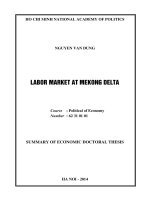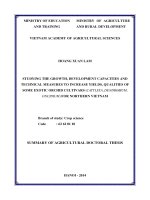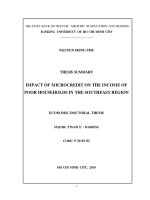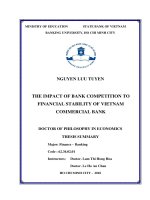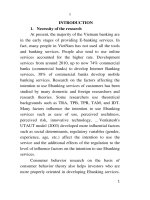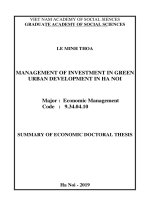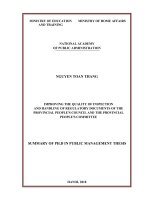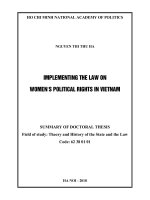Summary of economic doctoral thesis: Improving the efficiency of business activities of state enterprise after equitization in Vietnam
Bạn đang xem bản rút gọn của tài liệu. Xem và tải ngay bản đầy đủ của tài liệu tại đây (303.25 KB, 27 trang )
MINISTRY OF EDUCATION AND TRAINING
UNIVERSITY OF ECONOMICS OF HO CHI MINH CITY
-----------------------------
DOAN NGOC PHUC
IMPROVING THE EFFICIENCY OF BUSINESS
ACTIVITIES OF STATE ENTERPRISE AFTER
EQUITIZATION IN VIETNAM
Major: Political Economy
Code: 62.31.01.02
SUMMARY OF ECONOMIC DOCTORAL THESIS
Ho Chi Minh City - 2014
The work was completed at:
University of Economics of Ho Chi Minh City
The scientific instructors:
Dr. Nguyen Huu Thao
Dr. Nguyen Minh Tuan
Reviewer:
1.
2.
3.
The thesis will be protected in front of Thesis scoring council at the
University of Economics of Ho Chi Minh City
at ... hour ......day ......month ...... 2015
The thesis can be studied with:
- National Library of Vietnam
- Synthesis Scientific Library in Ho Chi Minh City
- Library of University of Economics of Ho Chi Minh City
PUBLISHED SCIENTIFIC WORKS
1. Doan Ngoc Phuc (2002), "Some measures to improve the
competitiveness of state-owned enterprises", Journal of Theoretic
Education, (9), tr.21-24.
2. Doan Ngoc Phuc (co-author) (2005), "The equitization of state-owned
enterprises - problems and solutions ", Journal of Political Science, (2),
tr.44- 48.
3. Doan Ngoc Phuc (2005), "Arsing Problems HCMC SOE equitization ",
Economic Development Review, (135), p. 15-18.
4. Doan Ngoc Phuc (2006), "Forming economic corporations under the
parent company - subsidiary of the state-owned corporations: the
problems, " Asia – Pacific Economics Journal (50), p. 19-21.
5. Doan Ngoc Phuc (2010), "Equitization of state-owned corporations:
situation and recommendations ", Journal of Economic Development,
(12). p.19- 22.
6. Doan Ngoc Phuc (2011), "Efficiency of production and business
activities of the enterprises after equitization", Journal of Political
Science, (3), p. 45-52.
7. Doan Ngoc Phuc (2011), "Transfer of shares in state-owned enterprises
after privatization: situation and corrective measures ", Journal of
Political Science, (6), p. 50-55.
8. Doan Ngoc Phuc (co-author) (2014), "The impact of corporate
governance to business performance of enterprises after privatization in
Vietnam", Journal of Economics & Development, 203, (5), p.56-63.
9. Doan Ngoc Phuc (2014), "The impact of capital structure to the
performance of the business after equitization in Vietnam", Review of
world Economic and Politics Issues, (7), p .72-80.
1
INTRODUCTION
1. Rationale of the thesis
Equitization of SOEs in our country continues to be promoted on
a national scale but also poses many problems to be solved. One of
the top concerns is how to implement successfully the equitization
goal and to improve the performance of the enterprise after
equitization. To do this is to improve the operations and the ability to
gain access to external resources, contributing to sustainable
development of the business. Therefore, improving the performance
of SOEs after equitization is not just a matter of every business itself
as the Corporation but also a tremendous impact on the progress of
equitization of SOEs and many aspects of economic - socio life.
When the performance of the enterprise is improved, it will minimize
the possibility of damage to the economy in front of the crisis, good
for planning policies of the Party and the state, and become basic
accumulated resources for social reproduction. As for now after
privatization, operational efficiency improvement will contribute to
strengthen the ownership of the investors, provide income to
employees, enhance the reputation of the enterprise in the market and
confirm the correctness of a major policy of the Party on innovation,
reorganization of state-owned enterprise system in accordance with
the structure of the economies in transition.
For state-owned enterprises after privatization, the goals of
equitization are implemented as promoting autonomy in the business,
increasing the state capital, mobilizing social capital to invest large
manufacturing business; renewing the management relationship and
distribution of products, enhancing the competitiveness of enterprises,
providing jobs for many employees, enabling employees to become
the real owners of the business after equitization, etc. However, the
activities of some enterprises after privatization revealed weaknesses
due to the difficulties of no longer receiving the privileges of the
Government such as credit, land, market information ... and the
outstanding issues after equitization such as settlement of redundant
labors or issues arising after the transfer of state-owned enterprises
2
into joint stock companies such as corporate management and
governance after privatization, the relationship of management of
stated owned capital in the enterprise after equitization; etc. All these
limitations have remarkable impact to the performance of the joint
stock companies after privatization of state enterprises.
To understand the status of business performance as well as the
difficulties and obstacles that hinder the operation of the equitization
enterprises, which provide a basis to propose the solutions and
recommendations to develop the capabilities and further improve the
operational efficiency of production and business of enterprises after
equitization of state-owned enterprises in Vietnam, I chose the theme
"Improving business performance of stated owned enterprises after
equitization in Vietnam "as economic doctoral thesis.
2. Objectives and research questions of the thesis
2.1. Research target of the thesis
Study the scientific and practice basis in the performance of the
SOE after equitization and propose solutions to improve business
performance for state-owned enterprises in Vietnam after equitization
2.2. Research question of the thesis
Based on the tasks of the thesis, the thesis will answer the
following key questions: what is the theory on business performance
of enterprises in general and SOEs after equitization in particular?
What is the reality of business performance of the SOEs after
equitization like? What measures need to implement to improve
business performance for SOEs after equitization?
3. Study subject and scope of the thesis
Subject of the study: business efficiency of the SOE after
equitization.
Scope of research: SOEs after equitization in Vietnam
4. Study methodology:
4.1. Qualitative Research Methods
Source of data collection: collected from the reports of the Board of
Enterprise Innovation and Development, GSO, published data from
scientific topics, the results of research by national and international
3
scholars, reports of some ministries, state owned corporations, local
corporation and from the interviews, surveys, investigations in 217
SOEs after equitization, taken in February and October 2012; Method
of data collection include: desk research, direct observation, surveys
using questionnaires, interviews to consult the experts, scientists, and
managers; Data processing: analytical, compare, synthesize, statistics
tools, etc. are used to highlight the overall picture of the status of the
business performance of state-owned enterprises, and clarify the
causes of the achievements, limit the weaknesses in the performance
of the SOEs after equitization.
4.2. Quantitative Research Methods
Source of data collection: thesis using data from the financial
statements of 217 companies listed on the stock exchanges in Hanoi
and Ho Chi Minh City; Method of data collection: the thesis uses
information taken from Annual listed companies yearbook of
Vietstock and desk research methods to calculate the necessary
criteria and refine the relevant information; Data processing: financial
reporting data of 217 SOEs after equitization stored as Excel file for
each year from 2007 to 2012, then formatting to Stata 12 to calculate
the variables measuring the efficiency of business such as ROA,
ROE, and other relevant variables such as total assets, equity, shortterm debt, long-term debt, Years of equitization, the number of board
members, state ownership, oversea ownership, etc. In addition, the
thesis also applies some analysis techniques such as statistical models
(average, median, standard deviation, etc.), and the thesis also uses
data regression analysis to assess business performance and identify
the factors affecting the performance of the SOE after equitization.
5. The research related to the thesis
5.1. International researches
There have been many worldwide studies on the performance of
enterprises in the various fields such as manufacturing, services,
finance, banking, etc. The research generally refers to the
measurement indicators of business performance, the relationship
between performance factors such as financial structure, company
4
size, business capital, etc. Some typical researching in this area may
include AJSingh, Ramond S.Schmidgall, Sanjai Bhagat, Brian
Bolton, Prasetyantoko Agustinus, Parmono Rachmadi, Rami Zatun,
Heibatollah Sami, Humera Khatab, Maryam Masood, Justin T. Wang,
Haiyan Zhou, Ong Tze San, The Boon Heng, Ming Cheng Wu, Hsin
Chiang Lin, Cheng Lin I, Chun Feng Lai, Costea Valentin, etc. who
have published many practical and valuable academic research works,
namely: Prasetyantoko Agustinus and Parmono Rachmadi (2008):
"Determinants of corporate performance of listed companies in
Indonesia,"
posted
on
the
website
/ MPRA Paper No. 6777, posted 17; Heibatollah
Sami, Justin T. Haiyan Wang and Zhou (2009): "Corporate
Governance and operating performance of Chinese listed firm"
presented at the annual conference of the European Accounting
Association and American Accounting Association; Humera Khatab,
Maryam Masood et al (2011): "Corporate governance and firm
performance: a case study of the Karachi stock market ", published in
the International Journal of Trade, Economics and Finance; Muzaffar
Muhammad Saeed, Ali Ammar Gull et al (2013): "Impact of Capital
structure on banking performance: A case study of Pakistan ",
published in the Journal of Interdisciplinary Journal of Contemporary
Research in Business.
5.2. National Researches
In Vietnam, the research on the effectiveness of business
operations in general and enterprises after equitization in particular
starts when there were advocacy of equitization of SOEs, ie at the
beginning of the process of innovation, and rearrangement of SOE
system. Since then, in Vietnam there have been some studies on the
operation of the SOEs after equitization which approaches to many
aspects and under different levels published in books, newspapers and
scientific subjects, economic journals. Among the research projects
related to business operations of SOEs after equitization which we
refer, there are some typical projects as follows:
5
Economic Doctoral thesis with the theme: "Financial
Management contributing to improve the competitiveness of the
economic corporation in Vietnam", by Vu Anh Tuan, protected in
2010; Economic Doctoral thesis: "Improving the management policy
of the state capital in state-owned enterprises after equitization" by
Tran Xuan Long, protected in 2012; Economic Doctoral thesis:
"Improving business efficiency analysis of the joint stock company
listed on the stock market in Vietnam" by Tran Thi Thu Phong,
protected in 2012; Article: "Equitization – the solution to develop the
private sector, a study in the area of Ho Chi Minh City," published in
Economic Development Journal, No. 5, 2011 by the author Vo Thi
Quy ; Article: "Financial support for state-owned enterprises after
privatization", published in the Journal of Economic Development,
no. 7, 2010 of Mai Cong Quyen; "Managing a public company, listed
for businesses and investors ", CTQG Published house in 2010 by Le
Minh Toan," Financial analysis of joint stock company", Published
by the National Economics University, Hanoi in 2010 by Nguyen
Van Phuc, etc.
In general, studies on the effectiveness of business operations of
SOEs after equitization has been raised in a number of articles,
research works. However, it is only the side view from different
aspects without deep study systematically and comprehensively on
the status of business operations after equitization of SOEs, to find
out the cause, point out the problems arising in the course of
operations, as well as propose complete solutions. Therefore, the
issue of enhancing the performance of SOEs in Vietnam after
equitization need more comprehensive, systematic and deeper
researches to meet the demands of reality.
6. Scientific contributions of the thesis
The contents of the thesis have the following new features:
- The Thesis systematized theoretical framework and outline the
overall picture for the performance of the SOE after equitization. On
this basis, the thesis points out the limitations and the cause of the
6
limitations in business activities of the SOEs after equitization in
Vietnam in recent years.
- Generalizeed experience of improving business performance for
SOEs in China after equitization, the country with similar conditions
to Vietnam to apply the measures for improving business
performance of SOEs in Vietnam after equitization.
- Qualitative research results of the thesis by developing a
questionnaire study has identified the problems arising in the
operation of the SOEs after equitization and pointed out the factors
that affect performance of the SOEs after equitization.
- The results of the thesis is the basis to adjust state policies for
enterprises after equitization and propose suitable major solutions to
promote the advantages, capabilities and improve business
performance business enterprises after equitization in our country
today.
- Results of quantitative research methods through the use of
regression analysis of table data, the thesis estimates research models
based on data collected from 217 firms and determine the impact of
these factors on the business performance to the SOEs after
equitization.
- The results and methodology of the thesis can be oriented for
further research in evaluating and measuring factors affecting the
performance of the enterprise activities of other types of enterprises
(SOEs, private domestic enterprises or enterprises with foreign
investment, etc.).
7. Outline of the thesis
The outline of the thesis: apart from the introduction, conclusion,
tables, diagrams, charts, lists of abbreviations, reference, the content
of the thesis is shown in 3 chapter, 9 section and 163 pages.
7
Chapter 1:
RATIONALE FOR BUSINESS PERFORMANCE OF STATE
OWNED ENTERPRISES AFTER EQUITIZATION
1.1. BUSINESS PERFORMANCE OF ENTERPRISES
1.1.1. The concept of business performance
On the basis of inheriting the different notions of efficiency of
production and business activities of enterprises, the thesis introduces
the concept of business performance of enterprises as follows:
Business performance of enterprises is the economic categories
reflecting the level and quality of using available resources in
business operations with minimum cost to achieve the highest results.
Business performance of one enterprise is a broad concept,
covering the performance in terms of both economic and social
aspect; is a measure of leadership and use of corporate resources to
maximize results and minimize costs to achieve business goals.
1.1.2. System of evaluation criteria for business performance
The scientific theories divide the financial performance of the
enterprises into two categories: classic financial indicators and
modern indicators. The classic indicators include indicators reflecting
the productivity, profitability like the profit out of assets, the rate of
profit on equity, profit on the sales, profit compared to the cost, basic
earnings per share, etc. These modern indicators measure the
effectiveness o based on the market value added (MVA) and
economic value added (EVA). In general, there are many indicators
used to evaluate the business effectiveness of enterprises, but because
business activities are so lucrative so the indicators reflecting the
profitability is commonly used.
1.1.3. Necessity to improve the business performance of stateowned enterprises after privatization
Operational efficiency in general and business performance in
particular is the objective in the operation of the enterprise.
Improving the performance of the enterprises after privatization is
imperative, as an objective necessity, deriving from the following
causes: Firstly, due to the development needs of the enterprise itself
8
after privatization; Secondly, to meet the requirements of
industrialization and modernization of the country and increasing
international economic integration; Thirdly, response the
requirements of the state management of the enterprises after
privatization.
Improving the performance of state-owned enterprises after
equitization has the crucial meaning to the survival and development
of enterprises in the market economy, as well as meet many different
interests of the equities (enterprises, employees, managers, investors,
etc.), all factors contributing to business performance of enterprises.
1.2. FACTORS AFFECTING BUSINESS PERFORMANCE OF
THE ENTERPRISES
1.2.1. Basic characteristics of state-owned enterprises after
equitization
Firstly, the capital of shareholders (the State, employees and the
manager of the enterprises) in the form of purchase of shares,
supplement capital from business results, capital raising from
corporate funds; Secondly, the majority of employees of the
enterprises after privatization is the labor of state owned enterprises
before equitization; Thirdly, the organizational structure and
management board include: General Meeting of Shareholders, the
Board of Directors, Director (General Director) and the Supervisory
Board; Forthly, profit and risks sharing mechanisms are carried out
according to the principles of the shareholders' equity and profit of
joint stock company; Fifthly, the state retains a dominant role for a
number of key industries such as oil and gas, finance, banking,
electricity, telecommunications, maritime, etc.
1.2.2. Factors affecting the business performance of stateowned enterprises after privatization
According to the results of the previous studies, there are many
different factors that affect the business performance of enterprises
such as firm size, growing pace, age of the enterprise, capital
structure, Corporate administration (Board of Director structure, the
9
separation between the Chairman and CEO, the independence of the
Board of Directors, the Board of Directors’ scale).
1.2.3. Models and hypotheses
Based on theory and relevant research, analytical framework
assumed that the business performance of enterprises is determined
by firm size, growth rate, number of equitized years, fixed assets,
quality of human resources, corporate administration (Board of
Director structure, the separation between the Chairman and CEO, the
independence of the Board of Directors, the Board of Directors’
scale). The characteristics of the owners have an impact on business
performance of the enterprises measured by ROA and ROE.
Hypothesis H1: The scale of BOD has a negative impact on
business performance of enterprises; Hypothesis H2: the
independence of the Board of Directors has a positively impact on
business performance of the enterprises; Hypothesis H3: the
Chairman cum CEO has a negative impact on business performance
of the enterprises; Hypothesis H4: the experience of BOD affects
positively business performance of the enterprises; Hypothesis H5:
Qualifications of the BOD have a positive impact on business
performance of the enterprises; Hypothesis H6: Institutional
shareholders have a positive impact on the business performance of
the enterprises; Hypothesis H7: The ownership of BOD possesses a
positive impact on business performance of the enterprises;
Hypothesis H8: Foreign ownership has a positive impact on the
efficiency of business operations of the enterprises; Hypothesis H 9:
State ownership is inversely related to the efficient operations of the
business.
1.3.
EXPERIENCE
OF
ENHANCING
BUSINESS
PERFORMANCE OF STATED OWNED ENTERPRISES AFTER
EQUITIZATION IN CHINA AND LESSONS FOR VIETNAM
By studying the experience of China on improving business
efficiency for the enterprises after equitization, we can draw some
experience: Firstly, making corporate finance healthy; Secondly,
appreciate the management of enterprises; Thirdly, create a fair
10
business environment; Forthly, reduce state intervention; Fifthly,
increase control over capital assets of business in the state.
Chapter 2:
REALITY OF BUSINESS PERFORMANCE OF STATE
OWNED ENTERPRISES AFTER EQUITIZATION IN
VIETNAM
2.1. REALITY OF BUSINESS PERFORMANCE OF STATE
OWNED ENTERPRISES AFTER EQUITIZATION
2.1.1. Generalizing the equitization of state owned enterprises
After 22 years of equitization of state-owned enterprises, as of
May 2014 our country has completed the equitization for 4073
enterprises and parts of enterprises, in which local enterprises now
accounts for 58.2%; Ministerial enterprises account for 30.3%; the
enterprises under corporation accounts for 11.5%. Regarding capital
structure of the charter capital: 57% state owned, 14% owned by the
employees, 6% owned by foreign investors, 23% owned by other
investors. The equitization of state-owned enterprises in our country
has a tremendous impact on business performance of the enterprises,
reflecting on many aspects: value of total assets, revenues, profits,
budget.
2.1.2. Reality of business performance of state owned
enterprises after equitization
2.1.2.1. Surveying business performance of state owned
enterprises after privatization
Firstly, business efficiency through profit targets
Profit after tax per 1 business grew from 30,583 million in 2001
to 165,080 million in 2012 (14.3%); revenue increased from 378,480
in 2001 to 1,774,869 million in 2012 (an average increase of 13.8%).
In 2001 for 100 dong of net revenue, the enterprises generated by
8.08 dong profit after tax; then in 2012 for 100 dong of net revenue,
the enterprises after equitization generated 8.74 dong profit after tax.
Secondly, business performance through efficient use of property
The productivity of total assets increased from 299.9 billion in
2001 to $ 1860.7 billion in 2012 (increasing 6.2 times), in which the
11
productivity of long term assets increased from 8.4 billion years 2001
to 789.9 billion in 2012 (an increase of 94 times), the productivity of
short term assets increased from 82.9 billion in 2001 to $ 1393.2
billion in 2012 (16.8 times).
Thirdly, business efficiency through effective use of equity
capital
Coefficient of equity earnings increased from 0.02 in 2001 to
0.23 in 2012. Profit target increased together with the investment
value of equity resulting in a return on equity of increase over the
years, that is to say the effectiveness of capital use of the enterprises
after equitization is growing over the period 2001 -2012.
Fourthly, Business performance through revenue and profit per 1
employee
Revenue and profit per 1 employee respectively equivalent to
1557.5 million and 125 million in 2001 increased to 3784.4 million
and 330 million. Although the number of employees increased
annually, the revenue and profit per 1 employee is constantly
increasing over the period 2001 to 2012, which suggests that the
enterprises after equitization have operated effectively and constantly
expanding scale of operations.
Fifthly, business performance through liabilities rates to total
assets
The ratio of debt out of total assets of enterprises increased from
0.4 in 2001 to 0.55 in 2012. The ratio of debt out of total assets for
the period 2001 -2012 was 0.54. The average coefficient of funding
(equity/total assets) in the period 2001 -2012 was 0.58, which shows
that the enterprises after equitization now depend less on loans, and
thereby reduces loan costs and risks in business.
Sixthly, business efficiency through the implementation of
obligations to the State
The business performance of the enterprises after equitization
also expressed through the budget contributions: one enterprise after
equitization has increased corporate income taxes in the budget from
9.75 billion in 2001 to $ 35.92 billion in 2012 on average.
12
2.1.2.2. Reality on the ownership, management and
distribution of state-owned enterprises after privatization
Property: After equitization, the enterprises establish clear
ownership; Most enterprises after equitization exist the situation that
the ownership are concentrated and controlled the most by the State;
Administration: the separation between ownership and management
rights, between the management of the owners and operation
management, and administration, between the inspection and control;
The enterprises now have more autonomy in production and business
and investment; the monitoring activities of the Supervisory Board
and shareholders have contributed to guarantee the stability and
security of financial indicators; Distribution: 73.4% of shareholder
dividends recognition over the years has increased, while the
remuneration for workers is also one of the decisive factors to attract
and retain workers capacity and is also a measure for the employees
to recognize and evaluate the performance of themselves in the
process of working.
2.1.2.3. Limitations and weaknesses of the business
performance of enterprises after privatization
The percentage of enterprises with profit tends to decrease and
the rate of enterprises with lost tends to increase; rate of tax payment
compared to revenue, rate of profit on capital and profit on revenue;
profitability of property assets and consumption of many businesses
tend to fall; the lack of stability in the enterprises after equitization
with major stated owned capital; fixed assets have not been
effectively exploited.
2.1.2.4. Main causes of the limitations and weaknesses
After equitization, the enterprises have now no longer enjoyed
preferential loans and other financial incentives; the adjustment to
increase enterprise value (book) increases the price due to increased
depreciation; not yet fully implemented the requirements on
diversification of ownership in the enterprise; fails to promote the
advantages of the model of joint stock companies; the enterprises’
leadership after privatization have not given up thinking and acting
13
according to the old mechanism, lack of dynamism in the new
mechanism, slow to grasp the progress of science and technology, not
invest equipment and advanced technology of production and
business.
2.2. EVALUATION OF FACTORS AFFECTING THE
BUSINESS PERFORMANCE OF STATE OWNED ENTERPRISES
AFTER EQUITIZATION
2.2.1. Source of data
The Thesis conducted the research with observation samples of
217 enterprises after equitization now listing on the stock exchanges
of Ho Chi Minh City and Hanoi in 2007-2012. Do not disclose
information from heterogeneous and non-mandatory information
disclosure should appear sample some missing data should be
excluded from the sample. Data of final thesis consists of the 447
observations.
2.2.2. Description of sample
ROA of businesses in the average ROE of 7.64% and 15.99%
average. The growth rate of average total assets of the company is
17.73%, the ratio of fixed assets / total average assets was 0.29;
Average age of the first business 12 years, debt ratio (debt / total
assets) with the average value is 0.51. Scale average BOD 5 people
with an average age of 56, and some independent members of the
Board average of 2.67 people. Percentage of board members have
graduate degrees or above average 12:42, the average percentage of
ownership of the Board of Directors is 36.74%. Ownership of water
held in average 28.87%, the percentage of foreign ownership on
average about 2.69%, while the proportion of state ownership is
18.57% average.
2.2.3. Results of the study the impact of factors affecting
business performance of enterprises after privatization
2.2.3.1. Theoretical models
Models of thesis research using panel data (panel data) are
regressed by 3 ways: pooled, random effect (random effects) and
fixed effects (fixed effects). To find out regression method is the most
14
appropriate of the three methods, we use the inspection: F inspection,
testing Lagrangian Multiplier (LM test, Breusch and Pagan, 1980)
and Hausman test (Hausman, 1978).
2.2.3.2. The variables in the model
The dependent variable is measured by ROA and ROE, while
independent variables included: Board size (Boardsize), the part-of
Chairman (Duality);
experience of the Board of Directors
(Boardage), the independence of the Board of Directors (Outboard),
lie in the specialized tissues of the Board of Directors
(Boardqualified), owned by the Board of Directors (Boardshare),
owned organizations (Institution), foreign ownership (Foreign ), state
ownership (State) and the control variables include: firm size (size):
measured by the natural logarithm of total assets; growth (Growth),
the age of the business, debt ratio (Leverage).
2.2.3.3. Results of testing the impact of factors affecting
business performance of enterprises after privatization
Based on the regression results show that the factors affecting
business performance of enterprises with different results include the
impact factor, the negative impact factor and the human no impact
factor:
- The impact factor: there is a positive relationship between the
statistical significance of the Board of ownership and enterprise
efficiency measured by ROA. Regression coefficients of ownership
Board was found to have had a positive impact to the ROA
statistically significant at the 10%. The regression results also show
that the independence of the Board of Directors to have a positive
impact on ROE at 1% significance level, but the effect is not
statistically significant to ROA. In addition, the regression results also
show that there is a positive relationship with statistical significance
at the 10% significance level between the Board and the effective size
measured by ROE.
The results from the two models have also found a positive
relationship with statistical significance between asset growth and
15
efficiency ROA and ROE measured by, all the regression coefficients
of financial growth significant at the 1% significance.
Firm size effect relationship has significant positive turn in the
5% significance level to effectively measured by ROA, but no impact
on ROE. The regression results also showed that the age of the
business (number of years equitization) have significant positive
impact on the efficiency statistics ROA and ROE measured by 1%
significance level.
- The negative impact factor: in addition to the positive
relationship as mentioned above, the regression results also show that
there is a negative relationship between the statistical significance of
the chairman concurrently with ROA at 5% significance level.
- These factors have no impact: The results of this study did not
show a relationship between institutional ownership and performance
of the enterprise after equitization. This shows that the organization is
not interested in supporting business knowledge and experience to
improve the efficiency of their companies. Results of regression
analyzes of foreign ownership and performance of the enterprise after
equitization showed no relationship between the statistical
significance of foreign ownership ROA and ROE for. In addition, the
size of the Board, the qualification of the Board, the debt ratio, the
proportion of state ownership with the data collected is not sufficient
grounds to prove significant impact on ROE and ROA statistics to of
business after equitization.
Thus, the results of studies have supported the hypothesis firm
size, number of years of equitization, asset growth, the part-of
Chairman, the percentage of ownership and independence of the
Board of Directors Board of impact on the business performance of
the enterprise after ROA and ROE measured by equitization.
2.3. ISSUES ARISING IN THE OPERATIONS OF THE
STATE OWNED ENTERPRISES AFTER EQUITIZATION IN
VIETNAM
2.3.1. Financial supervision and State management of state
owned enterprises after equitization
16
After equitization, state management for enterprises exist some
shortcomings: regime governing body no longer, many enterprises
after equitization very embarrassing in operation; there is no legal
framework for businesses that occupy a dominant share of water;
State intervention against the company after privatization is still quite
popular; the issue of financial disclosure and financial reporting
system is generally low; management mechanism is not clear,
especially on the role of state management as well as the direction
and control of the agencies assigned functional state shareholders
make business and production activities in a number of enterprises
stagnation, state assets are at risk of derelict.
2.3.2. Management of the state capital, and representatives of
state capital in state-owned enterprises after privatization
The issue of state capital management at the enterprise after
equitization emerging issues: First, distributed in many organs;
Secondly, the increase in charter capital reduction is not clearly
defined; Thirdly, there is no mechanism for solving all the financial
problems after equitization, Forthly the problem of accounting,
capital management, as well as the state capital of shareholders
confused; Fifthly, the issue of state representatives have not been
clearly defined; Sixthly, determining ownership assets of enterprises
inadequate businesses that have difficulty in implementing business
expansion, joint ventures, business cooperation with partners.
2.3.3. Discrimination against state-owned enterprises after
privatization
The transition from state owned enterprises to the Corporation
has brought a different business environment but also new difficulties
arise. The issue of primary concern now is that credit, land,
administrative procedures, etc. Although in practice in recent years
has had a lot of support policies for business after privatization was
enacted, but stability, uniformity is not high, even overlapping,
conflicting should have taken advantage of the negative trend,
especially tax incentives, credit policies ... Besides which, lack of
interest and support of the industry, the level of business after
17
equitization has reduced the effectiveness of incentives for state
enterprises after privatization.
2.3.4. Transfer of shares in state-owned enterprises after
privatization
In the equitization process, policy preference shares sold to the
government employees have been applied done from the start
equitization process. However, in practice workers holding only a
very small proportion of shares, almost negligible because after a few
years of corporate shareholders equity has transferred some of its
shares or intermediary to help others sell, transfer of shares to private
enterprises outside. This phenomenon can make the difference
direction and is in danger of equitization process of privatization of
state enterprises after privatization, losing the role of the State and the
workers in the enterprise, not in true to the original purpose of the
equitization of state-owned enterprises.
2.3.5. The role of social and political organization (party,
union) in the state-owned enterprises after privatization
The relationship between the Party organizations and unions in
many enterprises equitization can work quite well for the Party and
the trade unions in these enterprises have the advantage of being
available by Party organizations and trade unions from now State
move to .. However, in many places, the role and position of the Party
organizations and trade unions are limited, eclipsed during the
operation of the company shares. Trade unions in some enterprises
after equitization not promote ownership of the activities involved in
corporate governance law, although unions are appointed
representatives of its stake in Companies participating candidates to
the Board and the Supervisory Board.
18
Chapter 3:
VIEWPOINTS AND SOLUTIONS TO ENHANCE BUSINESS
PERFORMANCE OF STATE OWNED ENTERPRISES AFTER
EQUITIZATION IN VIETNAM
3.1. BASIC VIEWPOINTS ON IMPROVING OPERATING
PERFORMANCE OF STATE OWNED ENTERPRISES AFTER
EQUITIZATION
To improve the business performance of enterprises, it should
thoroughly understand some basic notions of the following: First, the
point of development; Second, comprehensive perspective; Third,
practical standpoint, Forthly, unified view, Fifthly, benefit
perspective.
3.2. MAIN MEASURES TO IMPROVE THE EFFICIENCY OF
THE
BUSINESS
ACTIVITIES
OF
STATE
OWNED
ENTERPRISES AFTER EQUITIZATION
3.2.1. Micro solutions from the enterprises
3.2.1.1. Strengthening internal monitoring of state enterprises
after privatization
Clearly distinguish between ownership and management rights
business; enhance independence; professionalism and effectiveness of
the Supervisory Board; build effective internal control system of the
enterprise; strengthen supervision from investors and shareholders,
etc.
3.2.1.2. Improving governance in state-owned enterprises
after equitization
To improve corporate governance should implement measures
such as team building corporate management personnel
qualifications, abilities, qualities consistent with the requirements of
corporate governance after equitization; innovation management
apparatus in accordance with the legal status of the business after
conversion; enhance the responsibility of the Board; strengthening the
role of the independent members of the Board of Directors from
outside; effective monitoring of transactions with related parties;
19
detect and solve the problems that arise in business administration
after equitization.
3.2.1.3. Enhanced efficiency of capital using in state-owned
enterprises after privatization
For fixed assets: revaluation of fixed assets, depreciation expense
is calculated on the full costs and profits, to prioritize investments in
fixed assets to expand production scale business or modernization of
machinery and equipment; for assets: should avoid excessive material
reserves, valued the inventory management, regular inspection of the
raw material reserves, revaluation of current assets; For receivables
and payables: need to quickly convert the debt into shares, sell the
bad loans to commercial banks or debt trading companies to recover
part of the capital to reinvest for business and production activities.
3.2.1.4. Encourage physical benefits for the Board, the Board
of Directors, supervisory Board and motivate employees
The remuneration system for the Board, the Board of Directors
and the Supervisory Board should split into two parts: fixed part
(wage and salary allowances accounted for 50% of income) and
additional part as a result of business performance (50% of income).
For employees paid according to performance, quality and work
efficiency. In addition, there should be bonuses, incentive regime,
appointment and promotion; support workers to purchase preferred
shares.
3.2.1.5. Ensure and maximize the role of shareholders
Creating the conditions for successful implementation of
shareholder rights and their obligations; ensure equal treatment for all
shareholders, especially minority shareholders; enhance the role of
shareholders in the General meeting of shareholders; to protect and
create conditions for small shareholders to fully implement their
rights.
3.2.1.6. Restructuring of state enterprises after privatization
Need to restructure the organization of the management and
human resources; number of strategic shareholders as well as the
number of shares that shareholders holding strategy; also need to
20
restructure the market, strategic objectives, business plans, product
categories of goods and asset portfolio, financial appropriate; the
capital structure of the business, the rational use of loans.
3.2.1.7. Strengthening the role of the Party and the trade
unions in state-owned enterprises after privatization
Need to ensure good implementation of business strategies;
dissemination of corporate law and the charter company to the
employees understand the rights and obligations of his; check the
implementation of policies for employees; organizations launched the
movement of workers and mobilizing staff and workers in enterprises
participating in social activities, care for the improvement of working
conditions, help each other in their careers and in life.
3.2.2. Macro solutions from the State
3.2.2.1. Improve policies related to the operation of stateowned enterprises after privatization
Issuance, dissemination and guiding the implementation of
legislation on businesses; fix the overlap, inconsistencies between
policies; create a legal basis for the joint stock companies improve the
quality of governance; improve the mechanism of supervision and
evaluation of the effectiveness of state enterprises after conversion;
mandatory provisions on disclosure of information and transparency
of management for enterprises after privatization.
3.2.2.2. Promote business autonomy of state-owned
enterprises after privatization
The state agencies should limit its lowest level intervention by
administrative orders in process management, business
administration; promulgation of additional regulations on financial
management non-state enterprises; revised regulations controlling
share of the state; separation of ownership of the property, business
and macroeconomic management rights; limited to the lowest level of
part-time board member positions for staff doing work in the State
management agencies in the state enterprises.
21
3.2.2.3. Promote innovation in management mechanism and
regulation on representatives of state capital in state-owned
enterprises after privatization
It should be prescribed and uniform application of standards
represents the state owns shares in company shares to exercise the
rights and obligations of shareholders; legal framework for the
representation of state capital; define coordination mechanisms
between the direct management of the state capital; monitor the
implementation of the obligations of the direct management of the
state capital in enterprises after privatization; structure and balance
the state capital in the enterprise equitization.
3.2.2.4. Enhance Capacity financial oversight of state for state
enterprises after privatization
Regulations specific responsibilities of government agencies in
the provision of information, dissemination policy regime for
business after conversion; should assign responsibility for innovation
management committee of local enterprises to solve business
problems after privatization; clear rules on administrative
management in enterprises after privatization; required all state
enterprises have equitization shall make quarterly reports or annual
deadlines and strict criteria for the request.
3.2.2.5. Change supporting forms of the state for state
enterprises after privatization
Support enterprise equitization of training human resources;
Business Support equitization build a uniform information system
serving the inspection and supervision of the shareholders; building
trade promotion program with the support of the state; support
changing corporate governance corporate law; development
organizations and investment services for the operation of the
company shares.
3.3. SOME RECOMMENDATIONS
To improve the business performance of state-owned enterprises
after equitization to meet the objectives of SOEs, the thesis proposes:
3.3.1. For Government
22
Clarify and specify the conditions of Chairman cum Director
(General Director), requirements on board members who must have
experience in the field of business enterprises; strengthen sanctions
against businesses after equitization.
Specifying the management functions of state in the Ministry,
provincial responsibility, the central cities, State Capital Investment
Corporation, the company purchases the outstanding debts and assets
and the relationship between these agencies in dealing with issues
related to equitization and business activities of enterprises after
equitization; and undergoes new organizational structure, the
apparatus of the Board of innovation and business development
function-oriented restructuring process, monitoring the enterprises
after equitization.
3.3.2. For the province, central cities
To advise the Government in issuing the policy relating to
equitization and operation of businesses after equitization; Regular
Steering review, assess the status of business activities of enterprises
after equitization; complete financial institutions, enhance the
effectiveness of the provisions of the state relating to business
activities after equitization is established in the legislation; Guide and
support enterprises in the study of equitization to use of modern
management principles in the management of business operations of
the business.
3.3.3. For state-owned enterprises after privatization
Strengthening the involvement of the independent members of
the Board of Directors from outside to improve transparency,
openness in business administration; choose the Board members are
experienced, skilled strategy, understanding the business areas of the
business; construction sequence and the target system performance
evaluation of the Board, using the management principles of the
OECD; strengthening financial, debt restructuring, debt ratio to
ensure a reasonable level; intensive training on modern management
knowledge for managers at all levels will help businesses more aware
of information transparency, accountability as well as the particular

